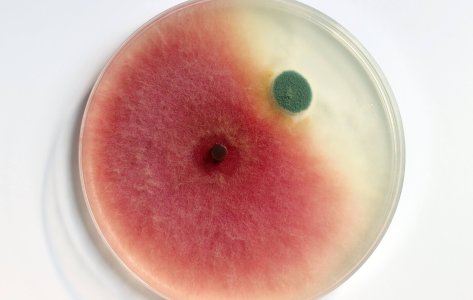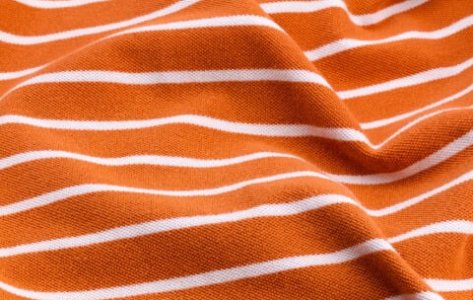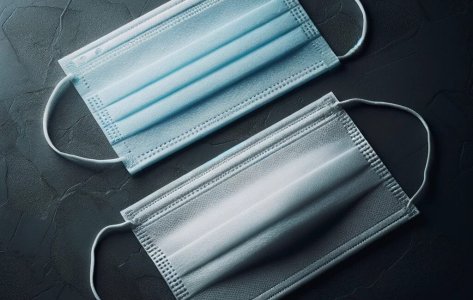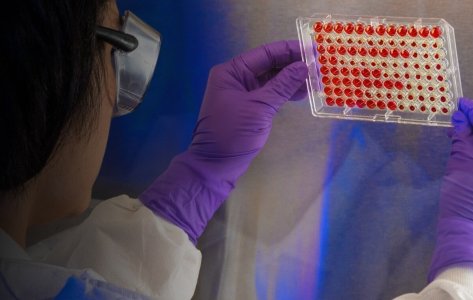- Swiss testing laboratory
ISO 17299/3A
Gas chromatography test method for the deodorant testing of textile products

Hassle-free testing experience
Need to get a product tested? No worries! To and fro logistics are on us; we collect your products, test them and, deliver them back to you.
Related tests for you
Antifungal Activity, Assessment on Textile Materials: Mildew and Rot Resistance of Textile Materials
Determination of Antiviral Activity of Textile Products
Determinate Antiviral Activity of Textile Products
Quick understanding about test
ISO 17299/3A - Gas chromatography test method for the deodorant testing of textile products
Applicable to a wide range of textile products such as woven fabric, knit, yarns, and more.
- Three test and three control samples are prepared in conical flasks.
- Flasks are purged with nitrogen gas and sealed.
- Odor component solutions are injected, and flasks are left undisturbed for 2 hours.
- Flasks are shaken vigorously to mix the contents.
- Gas samples are analyzed via gas chromatography to measure odor component concentrations. know more here.
- Accurately measures a textile's capacity to neutralize odor-causing compounds.
- It supports product development.
Do you have a product that needs testing?
Abstract
Getting rid of the unpleasant and peculiar odor from clothes is a common and perhaps challenging problem for many individuals. Primarily, bacteria, grime, sweat, and humid conditions give rise to this unpleasant odor. The fact here to understand is that the fabric of cloth plays a big role in masking or releasing bad odors.
With continuous research and technological advancements, textile products are being developed that have the ability to reduce the unpleasant odors deposited on clothes either by sweat or other environmental factors. And to evaluate the deodorant properties of such clothes, test methods have been developed by ISO (International Organization for Standardization).
The ISO 17299
ISO 17299 specifies a gas chromatography testing method to determine the deodorant property of textile products such as –
- woven fabric,
- knit,
- nonwoven,
- yarns,
- braiding products,
- tapes,
- and slings.
Test procedure
ISO 17299 test has two different preparation methods i.e. method A and method B.
Method A – An odor chemical is added to a container with the specimen, avoiding direct contact with the specimen. Here each chemical is tested individually.
Method B – An odor chemical is injected directly onto the specimen in a container. Here a mixture of chemicals (acetic acid and sodium chloride, NaCl) is tested together.
ISO 17299/3 A
At MIS, we use method A for the deodorant testing of textile products –
- This test is carried out in 6 conical flasks with a capacity of 500 ml.
- 3 conical flasks are used for testing (with a specimen) and 3 conical flasks are used as a control test (without a specimen).
- Purge the air of the conical flask by blowing 1000 ml of nitrogen gas.
- The test specimen flasks and the blank/control flasks are sealed with a sealing film.
- Odor component chemical solutions (Indole, Isovaleric acid (98% purity), and Nonenal (95% purity) are prepared and tests are performed for each odor component chemical independently.
- 5 microliter of odor component chemical solutions is injected through sealing film at the bottom of the conical flask while avoiding contact with the specimen. The same procedure is repeated for the control specimen as well.
- Microsyringe holes are sealed with a sealing film.
- Conical flasks are kept at a still position for 2 hours.
- At the end of the contact time, flasks are shaken vigorously approximately 20 times for 20 seconds.
- Testing gas is collected from both conical flasks (test and control) using a gastight syringe and is injected onto a gas chromatography to determine the concentration of odor component chemicals.
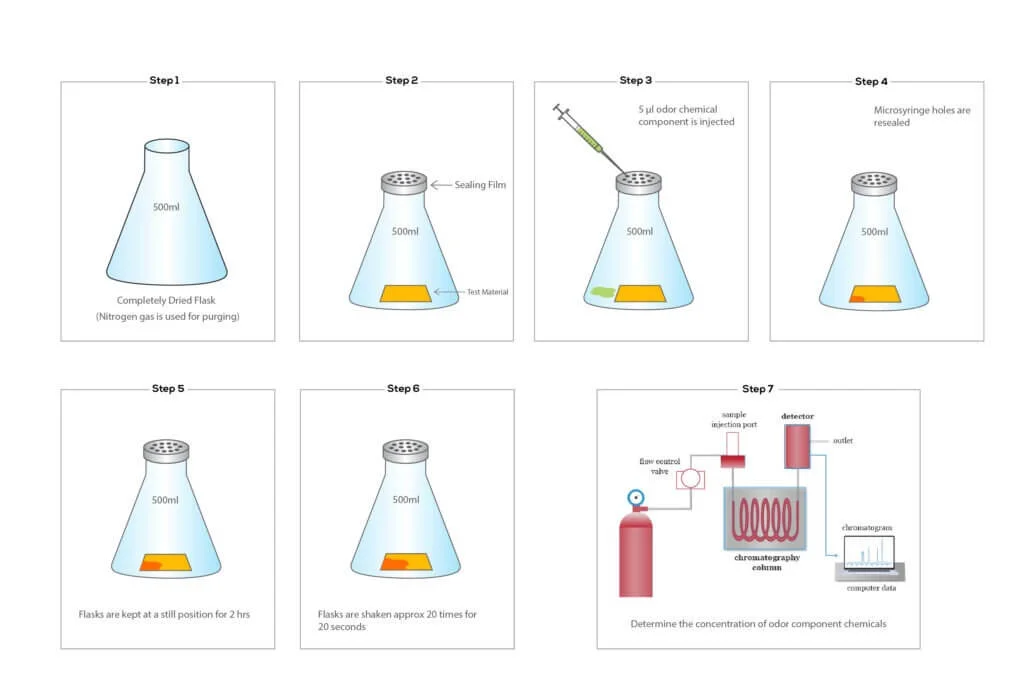
Importance of ISO 17299-3A Test
ISO 17299-3A is a critical standard for evaluating the deodorant properties of textiles using gas chromatography method. This test ensures that textile materials effectively neutralize or reduce odors by quantifying their ability to absorb or break down specific odor-causing compounds. By standardizing the testing procedure, ISO 17299-3A helps manufacturers ensure product consistency, meet regulatory compliance, and enhance consumer satisfaction by offering scientifically validated odor-resistant textiles.
Benefits of ISO 17299 Test
Enhances Consumer Trust – Provides reliable odor-reducing claims for marketing.
Standardized Testing – Provides comparability and consistency between various labs and products.
Regulation Adherence – Assists manufacturers in complying with international quality specifications of deodorizing fabrics.
Enhanced Product Development – Facilitates innovation in odor-control textiles by providing measurable performance information.
Conclusion
At Microbe Investigations Switzerland (MIS), we specialize in ISO 17299 deodorant property testing to help manufacturers validate the deodorant properties of their textiles. Whether you’re developing sportswear, home textiles, or any other fabrics, our expert analysis helps you stay compliant, competitive, and consumer-trusted.
To get a quote on ISO 17299 testing or want to know more about testing services, talk to our experts here.
Frequently Asked Questions

DR. Martinoz Scholtz
ISO 17299 is a standard test method developed for the deodorant testing of all textile clothes.
This method is applicable to the odor component chemicals, such as indole, isovaleric acid,
nonenal, and a mixture of acetic acid and sodium chloride (NaCl).
This test method applies to the deodorant testing of all textile clothes such as woven fabric, knit, nonwoven, yarns, braiding products, tapes, and slings.
The turnaround time for ISO 17299 test is 2-3 weeks.
Meet the best of the blend of
R&D, Efficacy Testing,
Innovation and Passionate
Experts at MIS.





Explore More
Microscopic spores of fungi and
Face masks coated with antibacterial
Introduction The Japanese Industrial Standards
What is ISO 18184 Testing?
ISO 17299/3 A
ISO 17299 test has two different preparation methods i.e. method A and method B.
Method A – An odor chemical is added to a container with the specimen, avoiding direct contact with the specimen. Here each chemical is tested individually.
Method B – An odor chemical is injected directly onto the specimen in a container. Here a mixture of chemicals (acetic acid and sodium chloride, NaCl) is tested together.
ISO 17299 test has two different preparation methods i.e. method A and method B.
Method A – An odor chemical is added to a container with the specimen, avoiding direct contact with the specimen. Here each chemical is tested individually.
Method B – An odor chemical is injected directly onto the specimen in a container. Here a mixture of chemicals (acetic acid and sodium chloride, NaCl) is tested together.
Getting rid of the unpleasant and peculiar odor from clothes is a common and perhaps challenging problem for many individuals. Primarily, bacteria, grime, sweat, and humid conditions give rise to this unpleasant odor. The fact here to understand is that the fabric of cloth plays a big role in masking or releasing bad odors.
With continuous research and technological advancements, textile products are being developed that have the ability to reduce the unpleasant odors deposited on clothes either by sweat or other environmental factors. And to evaluate the deodorant properties of such clothes, test methods have been developed by ISO (International Organization for Standardization).
